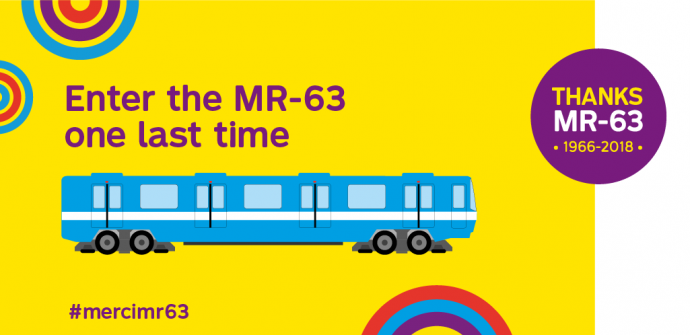A special tribute to the last MR-63 train on its last day of customer service with métro’s builders of the time.
Montréal, June 21, 2018 – To mark the occasion of the last day in service of the original MR-63 train, Mr. Phillipe Schnobb, Chairman of the Board of Directors of the Société de transport de Montréal (STM), and the métro’s builders Roger C. Choquette (engineer and director), Guy R. Legault (architect and urbanist) and Morley L. Smith (industrial designer) took their last ride aboard the train on the Blue line this morning, in the presence of Mr. André Fortin, Minister of Transport, Sustainable Mobility and Transport Electrification, as well as Mr. Craig Sauvé, vice-chair of STM and City Councillor, district of Saint-Henri-Est–Petite-Bourgogne–Pointe-Saint-Charles–Griffintown.
“This is a historic moment for the STM. After 52 years of loyal service and having travelled more than four million kilometres each since they were commissioned in 1966, the MR-63 métro cars made their farewell passenger service tour this week. To mark the occasion, Montrealers had the chance to say their final goodbyes as it ran on each line in the system during the morning and evening rush hours. It was also the first time that a MR-63 train ran on a schedule on the Blue line!” Mr. Schnobb says.
“The MR-63 is my favourite design. It was a new passenger-focused concept, an interior that looked like a comfortable space instead of a freight car. We created a distinctive style that could last for many years,” says Morley L. Smith, industrial designer.
“The MR-63 is an original and authentic product of successful contemporary industrial design: pleasant, comfortable, efficient and durable cars, and much more. It was a breakthrough in the wall of conformism of the time adds,” Guy R. Legault, architect and urbanist.
“I had the opportunity to walk through the tunnels and the stations before the trains arrived. It was a beautiful underground city, but without a soul. When the first MR-63 cars started rolling, I felt the métro coming to life,” says Roger C. Choquette, engineer and director.
Interesting trivia from the past
- The MR-63 cars were made by Canadian Vickers in a former shipyard at the corner of Notre-Dame and Viau.
- Originally, the fronts of the MR-63 cars were painted white. It wasn’t until the 1990s that the white band on a blue background was introduced to harmonize with the MR-73 cars.
- In 1966, there was no writing or logo on the MR-63 cars, except for the first train, which had the Montréal coat of arms on the side of the lead car.
- When the métro first opened, there were two operators in each train, one at the front and one at the back. The first drove the train while the second was in charge of closing the doors.
- The MR-63 cars have kept their original directional signs to the end, with the following destinations (terminus and switching locations): 1 – Atwater, 1 – McGill, 1 – Berri-De Montigny, 1 – Frontenac, 2 – Henri-Bourassa, 2 – Crémazie, 2 – Beaubien, 2 – Berri-De Montigny, 2 – Bonaventure, 4 – Berri-De Montigny and 4 – Longueuil.
- The MR-63’s seats were upholstered with black imitation leather, and the cars had wood flooring. But they didn’t hold up to the ravages of time and were replaced in the early 1990s.
- The MR-63 cars were equipped with a heating system which was never used. Instead it became necessary to increase the ventilation and replace certain windows with expanded metal sheeting. The installation of more powerful fans led to the addition of trapdoors on the roofs of the MR-63 cars, making it necessary to raise the ceiling in certain parts of the métro.
A second life for the MR-63 cars
The MR-63s will have second lives after their removal. Their parts are being reused, some cars were dismantled and recycled, and some are being repurposed for special projects. In 2017, this valorization represents more than 3,400 tonnes of material.
It is worthwhile mentioning the project in the Jardins de Métis, which had a métro car on display featuring its link with Montréal, and artist Michel Broin’s project called Seuils (Thresholds), an installation involving 16 MR-63 doors and their opening-closing mechanisms, which was exhibited in the Quartier des spectacles in 2017.
“To continue the MR-63’s journey, number 81-502, the same car that was inaugurated by Mayor Drapeau and Cardinal Léger in 1965, will be on display starting this fall at Exporail, the Canadian Railway Museum, in Saint-Constant. It’s a must-see for métro lovers,” Mr. Schnobb says.
The MR-63 in numbers:
- Original order of 369 cars: 123 trailer cars numbered 80-0001 to 80-0123 and 246 motor cars numbered 81-1501 to 81-1746 (the third figure in each number was removed in the early 1970s)
- Designed in 1963 by the firm Jacques S. Guillon & Associés
- Delivered between 1965 and 1967 by the firm Canadian Vickers at a cost of $45.5 million
- 24 cars were destroyed in the fire of December 9, 1971
- 9 more cars were destroyed in the fire of January 23, 1974
- 3 cars from the former Jeumont train (used to test the chopper of the MR-73 cars) were removed from service prematurely
- Final number of the MR-63 cars: 333
- Distance travelled by each car since 1966: more than 4 million kilometres
- Empty weight: 27,000 kg for a motor car and 20,000 kg for a trailer car
About the métro’s builders
Having joined the Montréal Transportation Commission in 1964, Roger C. Choquette knows all about the MR-63 métro cars. Initially an engineer, he climbed the ranks one by one, finally becoming Executive Director – Métro and Commuter Trains in 1989, and then Executive Director – Construction and Major Projects from 1995 until his departure from the Société de transport de Montréal in late 1997. Since then he has run his own consulting firm, enabling him to contribute to the métro’s expansion to Laval, among other projects.
Working for the City of Montréal from 1956 to 1987, Guy R. Legault headed up the departments of housing, urban planning and housing restoration, as well as the Montréal Housing Bureau and Montréal Housing Society. In the early 1960s, he was a key member of the team responsible for the design and construction of the initial Montréal métro system. He supported the involvement of architects in station construction and participated in choosing the rolling stock.
Morley L. Smith designed two generations of rolling stock for the Montreal métro: first, the MR-63 cars for Jacques Guillon et Associés, and then the MR-73 cars for Guillon, Smith, Marquart et Associés, which later became GSM Design and then GSM Project. During his long career as an industrial designer, he screated several other vehicles and objects, such as the LRC high-speed Canadian train, snowmobiles, farm equipment and flight simulators.
-30-
Isabelle Tremblay
Affaires publiques
Société de transport de Montréal
medias@stm.info



